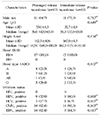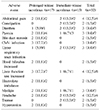1. Kim WR, Lake JR, Smith JM, Schladt DP, Skeans MA, Harper AM, et al. OPTN/SRTR 2016 annual data report: liver. Am J Transplant. 2018; 18:Suppl 1. 172–253.

2. Adam R, Karam V, Delvart V, Trunečka P, Samuel D, Bechstein WO, et al. Improved survival in liver transplant recipients receiving prolonged-release tacrolimus in the European Liver Transplant Registry. Am J Transplant. 2015; 15:1267–1282.

3. Christina S, Annunziato RA, Schiano TD, Anand R, Vaidya S, Chuang K, et al. Medication level variability index predicts rejection, possibly due to nonadherence, in adult liver transplant recipients. Liver Transpl. 2014; 20:1168–1177.

4. Beckebaum S, Iacob S, Sweid D, Sotiropoulos GC, Saner F, Kaiser G, et al. Efficacy, safety, and immunosuppressant adherence in stable liver transplant patients converted from a twice-daily tacrolimus-based regimen to once-daily tacrolimus extended-release formulation. Transpl Int. 2011; 24:666–675.

5. Rodrigue JR, Nelson DR, Hanto DW, Reed AI, Curry MP. Patient-reported immunosuppression nonadherence 6 to 24 months after liver transplant: association with pretransplant psychosocial factors and perceptions of health status change. Prog Transplant. 2013; 23:319–328.

6. Trunečka P, Boillot O, Seehofer D, Pinna AD, Fischer L, Ericzon BG, et al. Once-daily prolonged-release tacrolimus (ADVAGRAF) versus twice-daily tacrolimus (PROGRAF) in liver transplantation. Am J Transplant. 2010; 10:2313–2323.

7. Considine A, Tredger JM, Heneghan M, Agarwal K, Samyn M, Heaton ND, et al. Performance of modified-release tacrolimus after conversion in liver transplant patients indicates potentially favorable outcomes in selected cohorts. Liver Transpl. 2015; 21:29–37.

8. Stifft F, Stolk LM, Undre N, van Hooff JP, Christiaans MH. Lower variability in 24-hour exposure during once-daily compared to twice-daily tacrolimus formulation in kidney transplantation. Transplantation. 2014; 97:775–780.

9. Wu MJ, Chang CH, Cheng CY, Shu KH, Chen CH, Cheng CH, et al. Reduced variability of tacrolimus trough level in once-daily tacrolimus-based Taiwanese kidney transplant recipients with high-expressive genotype of cytochrome P450 3A5. Transplant Proc. 2014; 46:403–405.

10. Kuypers DR, Peeters PC, Sennesael JJ, Kianda MN, Vrijens B, Kristanto P, et al. Improved adherence to tacrolimus once-daily formulation in renal recipients: a randomized controlled trial using electronic monitoring. Transplantation. 2013; 95:333–340.

11. Eberlin M, Otto G, Krämer I. Increased medication compliance of liver transplant patients switched from a twice-daily to a once-daily tacrolimus-based immunosuppressive regimen. Transplant Proc. 2013; 45:2314–2320.

12. Dopazo C, Rodriguez R, Llado L, Calatayud D, Castells L, Ramos E, et al. Successful conversion from twice-daily to once-daily tacrolimus in liver transplantation: observational multicenter study. Clin Transplant. 2012; 26:E32–E37.

13. Dumortier J, Guillaud O, Boillot O. Conversion from twice daily tacrolimus to once daily tacrolimus in long-term stable liver transplant recipients: a single-center experience with 394 patients. Liver Transpl. 2013; 19:529–533.

14. Sańko-Resmer J, Boillot O, Wolf P, Thorburn D. Renal function, efficacy and safety postconversion from twice- to once-daily tacrolimus in stable liver recipients: an open-label multicenter study. Transpl Int. 2012; 25:283–293.

15. Valente G, Rinaldi L, Sgambato M, Piai G. Conversion from twice-daily to once-daily tacrolimus in stable liver transplant patients: effectiveness in a real-world setting. Transplant Proc. 2013; 45:1273–1275.

16. Kim JM, Kwon CH, Joh JW, Sinn DH, Lee S, Choi GS, et al. Conversion of once-daily extended-release tacrolimus is safe in stable liver transplant recipients: a randomized prospective study. Liver Transpl. 2016; 22:209–216.

17. Kim SH, Lee SD, Kim YK, Park SJ. Conversion of twice-daily to once-daily tacrolimus is safe in stable adult living donor liver transplant recipients. Hepatobiliary Pancreat Dis Int. 2015; 14:374–379.

18. Astellas Pharma Europe. Advagraf 0.5 mg, 1 mg, 3 mg and 5 mg prolonged-release hard capsules summary of product characteristics. Leiden, NL: Astellas Pharma;2015.
19. U.S. Multicenter FK506 Liver Study Group. A comparison of tacrolimus (FK 506) and cyclosporine for immunosuppression in liver transplantation. N Engl J Med. 1994; 331:1110–1115.
20. Margarit C, Bilbao I, Castells L, Lopez I, Pou L, Allende E, et al. A prospective randomized trial comparing tacrolimus and steroids with tacrolimus monotherapy in liver transplantation: the impact on recurrence of hepatitis C. Transpl Int. 2005; 18:1336–1345.

21. Jain AB, Kashyap R, Rakela J, Starzl TE, Fung JJ. Primary adult liver transplantation under tacrolimus: more than 90 months actual follow-up survival and adverse events. Liver Transpl Surg. 1999; 5:144–150.

22. TruneČka P, Klempnauer J, Bechstein WO, Pirenne J, Friman S, Zhao A, et al. Renal function in de novo liver transplant recipients receiving different prolonged-release tacrolimus regimens: the DIAMOND Study. Am J Transplant. 2015; 15:1843–1854.

23. Uemoto S, Abe R, Horike H, So M. Safety and efficacy of once-daily modified-release tacrolimus in liver transplant recipients: a multicenter postmarketing surveillance in Japan. Transplant Proc. 2014; 46:749–753.

24. Gastaca M, Valdivieso A, Bustamante J, Fernández JR, Ruiz P, Ventoso A, et al. Favorable longterm outcomes of liver transplant recipients treated de novo with once-daily tacrolimus: results of a single-center cohort. Liver Transpl. 2016; 22:1391–1400.

25. van Hooff JP, Alloway RR, Trunečka P, Mourad M. Four-year experience with tacrolimus once-daily prolonged release in patients from phase II conversion and de novo kidney, liver, and heart studies. Clin Transplant. 2011; 25:E1–E12.

26. Guirado L, Cantarell C, Franco A, Huertas EG, Fructuoso AS, Fernández A, et al. Efficacy and safety of conversion from twice-daily to once-daily tacrolimus in a large cohort of stable kidney transplant recipients. Am J Transplant. 2011; 11:1965–1971.

27. Okumura Y, Noda T, Eguchi H, Iwagami Y, Yamada D, Asaoka T, et al. Short- and long-term outcomes of de novo liver transplant patients treated with once-daily prolonged-release tacrolimus. Transplant Direct. 2017; 3:e207.

28. Coilly A, Calmus Y, Chermak F, Dumortier J, Duvoux C, Guillaud O, et al. Once-daily prolonged release tacrolimus in liver transplantation: experts' literature review and recommendations. Liver Transpl. 2015; 21:1312–1321.

29. Han N, Ha S, Yun HY, Kim MG, Min SI, Ha J, et al. Population pharmacokinetic-pharmacogenetic model of tacrolimus in the early period after kidney transplantation. Basic Clin Pharmacol Toxicol. 2014; 114:400–406.










 PDF
PDF ePub
ePub Citation
Citation Print
Print





 XML Download
XML Download